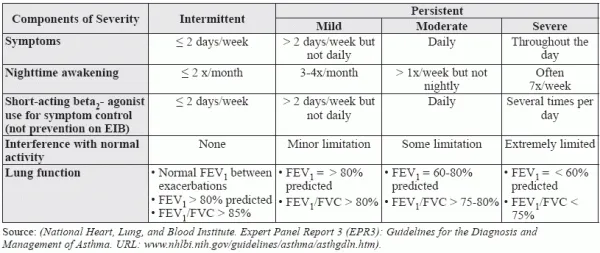Establish Severity to Make Asthma Coding Easier

Tip: Don't forget to code out to the fifth character in most cases. When a patient presents with asthma, you're likely to reach for the J45 (Asthma) code set, but you can't stop there. The ICD-10 guidelines dictate that you must code to the highest degree of specificity possible, which means you'll have to determine the appropriate fourth and fifth characters to assign to your ICD-10 codes before submitting your claims. Coding different asthma conditions accurately is simple if you follow the National Heart, Lung and Blood Institute (NHLBI) guidelines for asthma diagnoses and know the fifth digit ICD-10 codes for each degree of severity. First, Ask Intermittent or Persistent; Mild, Moderate or Severe Unlike many ICD-10 codes, the J45 code set uses the severity of the symptoms rather than the etiology of the condition as its subdivisions. This is consistent with the current asthma guidelines determined by the NHLBI, which classifies the conditions this way. The chart shows that the condition has four different states - mild intermittent, mild persistent, moderate persistent, and severe persistent - that correspond exactly with the following four code set category: A fifth code category, J45.9 (Other and unspecified ...) is reserved for forms of the condition that do not fit neatly into the established categories, such as asthmatic bronchitis, childhood asthma, or exercise-induced bronchospasm. The J45.2-J45.5 range requires code completion to the fifth character, whereas J45.9 requires code completion to the sixth digit. Then, Add 0, 1, or 2 for Full Reimbursement Each of the four code sets subdivide to describe the severity more specifically. For example, J45.2 expands into the following three subsets: As with the main code sets, the higher the number, the more severe the condition. So, you would document the most severe form of an asthma attack, status asthmaticus, with the highest fifth digit, 2. (The J45.90 code set, however, features an exception to that rule, reserving 9 as the sixth digit when the condition is uncomplicated.) This degree of precision is critical for asthma coding. "Many providers fail to use asthma codes to the highest level of specificity," said Donelle Holle, RN, a healthcare, coding, and reimbursement consultant in Fort Wayne, Indiana. "Using unspecified asthma codes may cause a decrease in reimbursement in the future due to risk management regarding diagnosis coding." Scenario: Your provider assesses a patient with asthma who is currently experiencing episodes of acute exacerbation. The patient suffers from symptoms at least twice a week, limiting the patient's daily activities somewhat. The patient also uses an inhaler more than twice a week, but not on a daily basis. Based on these symptoms, and the results of a pulmonary function test (PFT) that records a forced expiratory volume in 1 second (FEV1) >80%, your provider diagnoses an acute exacerbation of a mild persistent type of asthma. This would make J45.31 (Mild persistent asthma with [acute] exacerbation) the correct primary diagnosis in this scenario. Holle notes that "the use of an additional code such as Z72.0 (Tobacco use), F17- (Nicotine dependence...), or Z77.22 (Contact with and [suspected] exposure to environmental tobacco smoke [acute] [chronic]) can be very important if there is an exposure to smoke or if the patient smokes."




